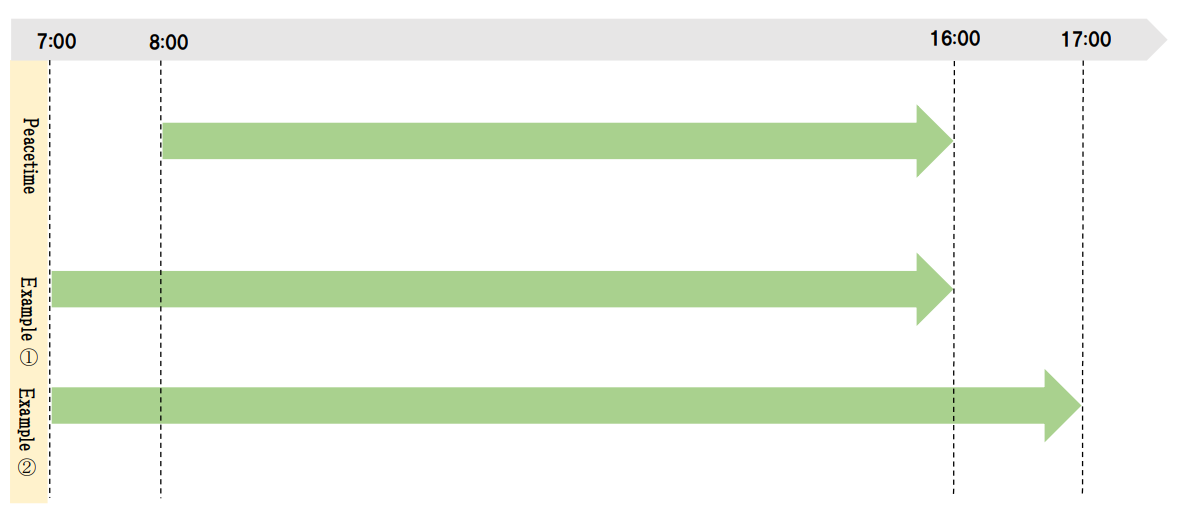Explanation of detailed changes regarding overtime and working hours
When you tap on the content of the reform you want to know, the content will drop down and appear.
It means that. However, break time tends to be a short break between each work, but this system is
This is not enough to get a good image, so let me explain with an example.
|
Let's say that one day you're not working and you want to stay in the company a little more and work overtime for 5 hours. Basically, work ends at 17:00 (assuming one hour of lunch break) due to legal working hours, so work ends at 22:00. Overtime is usually 3 hours, so the end of work is 20:00. If you come to work the next day at 8:00, you will usually have a 12-hour break, but it will be 10 hours. It's hard to reduce it for two hours. This is where the new interval systemcomes in. The extended overtime allows the start of work the next day to be brought forward. In this case, the overtime hours were two hours more than usual, so the next day's start time can be moved forward two hours. |

Self-made photo |

Therefore, there is a method in which an employer listens to a worker for five days during which he or she wishes to be paid for one year (obligation to listen to this worker is obligatory), and based on that, specifies the time of acquisition of the worker. Was In this way, the employer has to ask the worker when he or she wants to get paid, and the worker is guaranteed five days off per year.
| Conventional | After reform |
|---|---|
 |
 |
↑Self-made photo
|
Mr. A, who goes to a computer classroom every Monday and Thursday, must leave the company at 16:00 to be in time for the classroom. If you leave at 16:00, your working time will be one hour shorter than the legal working time (eight hours) (assuming your lunch break is one hour). That is where the flextime system comes into play. See the example in the figure below. Mr. A goes to work at 8:00 during normal times, but goes to work at 7:00 one day with a computer classroom. |

Self-made photo |

There are many other uses for the flextime system, such as avoiding the time of commuting to work (coming home).
Let's take a look at what actions are taken if actual working hours do not match the total working hours.
①When the actual working time exceeds the total working hours during the settlement period
Action:Additional wages are paid for the extra working hours.
②When the actual working time does not reach the total working time
Action1:If the sum of the additional time and the total working hours of the following month is within the legal working hours, add them to the total working hours of the following month to work.
Action2:Subtract the time not reached from wages.
The above is the content of the conventional flextime system.
From here, we will look at the contents of the reform.
First, there is one major difference that has changed. The content is that the settlement period has been extended to three months .
Just that? I think some people thought. Of course, this change alone is not a reform. I will explain some reform items based on the change of the liquidation period to three months.
The extension of the production period to three months allows for a wider schedule.
|
Let's say you have a company with a peak season of December in Christmas and New Year, and a low season in January, the beginning of the year.
According to the conventional system, the settlement period is one month, so we need to decide days to rest and work a lot in December alone. However, the company is busy all December and has no days off. In that case, employers have to pay a lot of extra wages, and workers will not be able to take the rest of their work as expected. Now, with the clearing period of three months, you can carry over the rest of your work in December to January. Then, the workers can spend the beginning of the year slowly and, as an employer, can pay extra wages for many of the work in December on days off in January. Workers and employers are in a win-win relationship. |

Self-made photo |
However, simply extending it to three months could lead to overwork in some months. Therefore, the rules for extending three months are as follows.
①:The weekly average working hours of the total working hours during the liquidation period should not exceed the legal working hours of 40 hours.
②:The average weekly working hours per month should not exceed the legally required working hours of 50 hours.
At this time, however, do not forget that the labor agreement must be submitted to the Chief of the Competent Labor Standards Inspection Office.

As you can see from reading the above, the government has prepared various measures to achieve its stated "Work Style Reform Aims".

